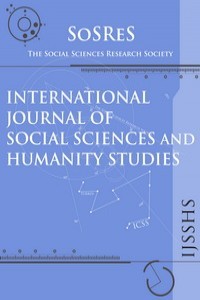THE CAUSES AND THE ECONOMIC IMPACT OF IMMIGRATION: EMPIRICAL EVIDENCE FOR LITHUANIA
THE CAUSES AND THE ECONOMIC IMPACT OF IMMIGRATION: EMPIRICAL EVIDENCE FOR LITHUANIA
immigration, repatriation, labor market economic indicators, econometric model,
___
- Brader T., Valentino N. A., Suhay E. (2008), “What Triggers Public Opposition to
- Immigration? Anxiety, Group Cues, and Immigration Threat”, American Journal of Political Science. Vol. 52, No. 4, pp. 959-978. Castles, S., Miller, M. (2003), The Age of Migration: International Population
- Movements in the Modern World. 3rd ed. Guilford Press, New York. IOM (International Organization for Migration) (2010), World Migration Report
- The Future of Migration: Building Capacities for Change. Geneva. Kaczmarczyk, P., Okolski, M. (2005), International Migration in Central and Eastern Europe – Current and Future Trends. UN expert group meeting on international migration and development UN/POP/MIG/2005/12.
- Lithuanian Department of Migration (2010), Migration Chronicles 2004-2010: http://www.migracija.lt, [Accessed 7.04.2012]
- Lithuanian Department of Statistics data (2012), Statistics (data bases): http://db1.stat.gov.lt/statbank/default.asp?w=1280, [Accessed 08.02.2012]
- Lithuanian Free Market Institute (2010), Migration: the Main Reasons and Guidelines for the Change. Vilnius.
- Mansoor A. M. (2006), Migration and Remittances: Eastern Europe and the Former Soviet Union. World Bank. Europe and Central Asia Region: http://www.google.com/siteresources.worldbank.org/INTECA/Resources/257896
- /Migration_FullReport.pdf, [Accessed 7.01.2012]
- Massey D. S. et al. (1993), „Theories of International Migration: a Review and Appraisal“, Population and Development Review, Vol.19, No 3, pp. 431-466.
- Moses J. (2006), International Migration – Globalization‘s Last Frontier. London: Zed Books.
- Nazarovienė D., Rastenienė A. (2009), „Migration: Problems and Actuality“,
- Journal of Management, Vol. 5, pp. 43-51. Palokangas T. (2008), „Self-Interested Governments, Unionization, and Legal and Illegal Immigration“, Czech Economic Review, Vol. 2, No. 1, pp. 7-20.
- Todea D.V. (2010), “Utilitarianism and Immigration”, Scientific Journal of
- Humanistic Studies. Vol. 2, Issue 3, pp. 39-46.
- Başlangıç: 2009
- Yayıncı: Sosyal Bilimler Araştırmaları Derneği
Gira Bhatt, Roger Tweed, Steve Dooley, Jodi VİLJOEN, Kevin DOUGLAS, Nathalie GAGNON, Kashmir BESLA
THE POST 9/11 DEMOCRATIZATION IN AFGHANISTAN: CHALLENGES AND EXPECTATIONS
Joss STEİNKE, Christopher OSİANDER
SARTRE’S CONCEPTION OF ART GROUNDED ON HUMANIST EXISTENTIALISM AND PHENOMENOLOGICAL ONTOLOGY
Nuray MERCAN, Emine OYUR, Ayşenur ALTINAY, Yaşar AKSANYAR
EXPLORING THE UNDERREPRESENTATION OF PRAGMATIC COMPETNECE IN THE L2 CLASSROOMS IN IRAN
Azizullah Mirzaei, Masoumeh Seyyed Rezaei
THE ROLE OF VIENNA IN THE LIFE OF MIHÁLY MUNKÁCSY, THE FIRST WORLD FAMOUS HUNGARIAN PAINTER
